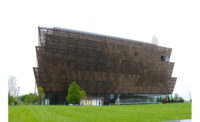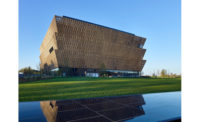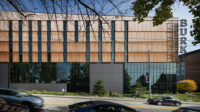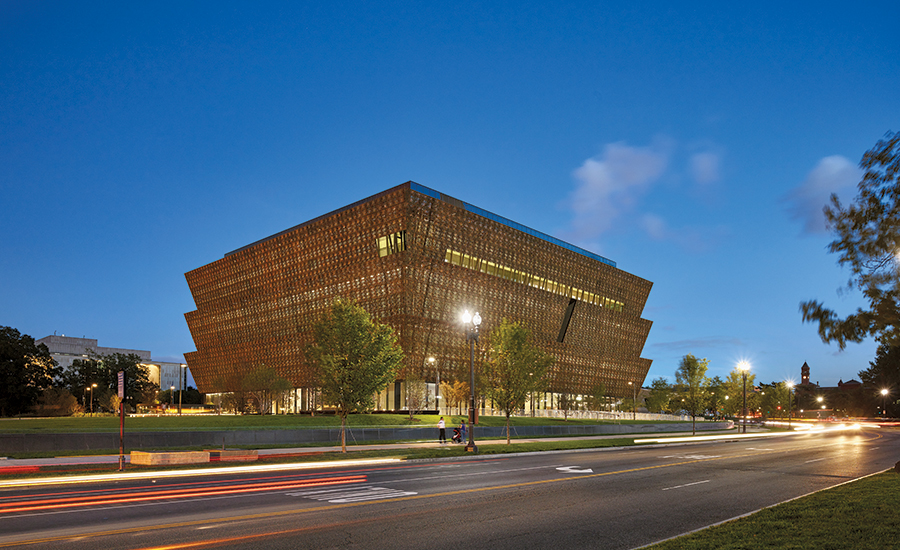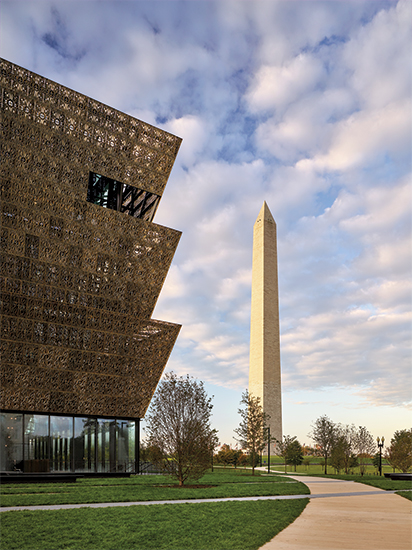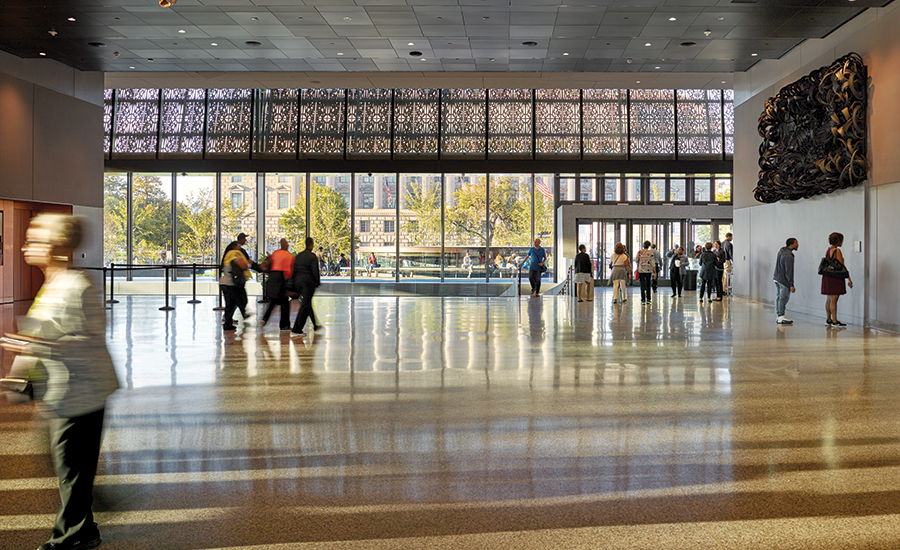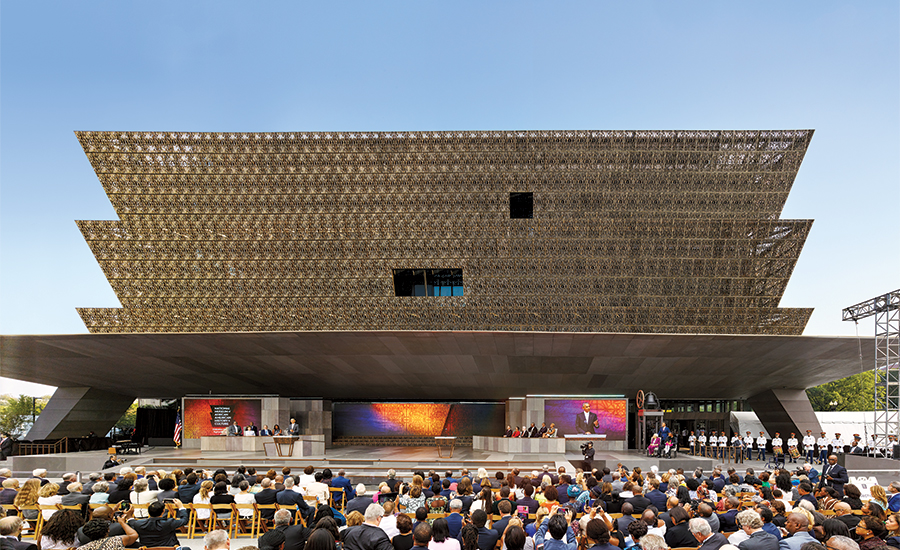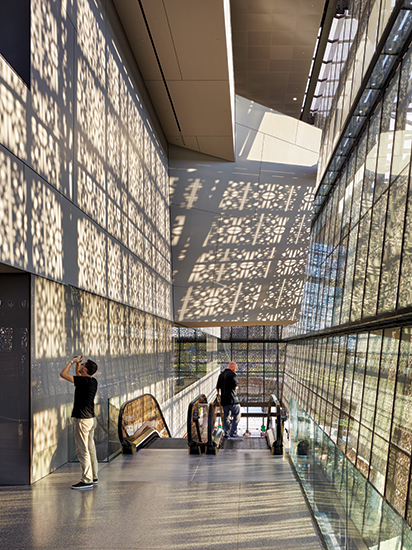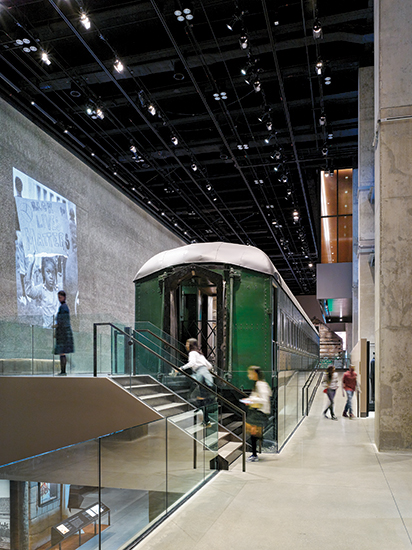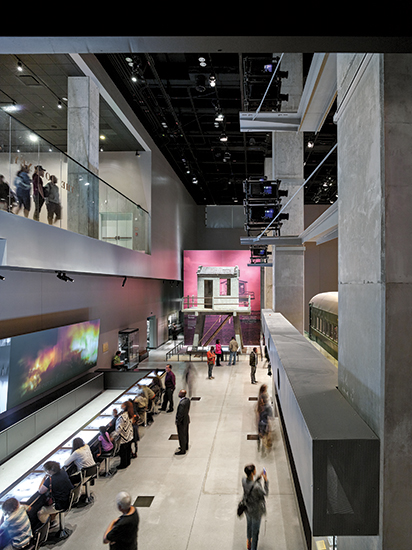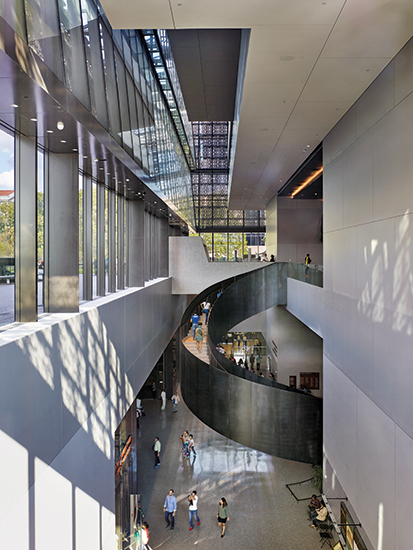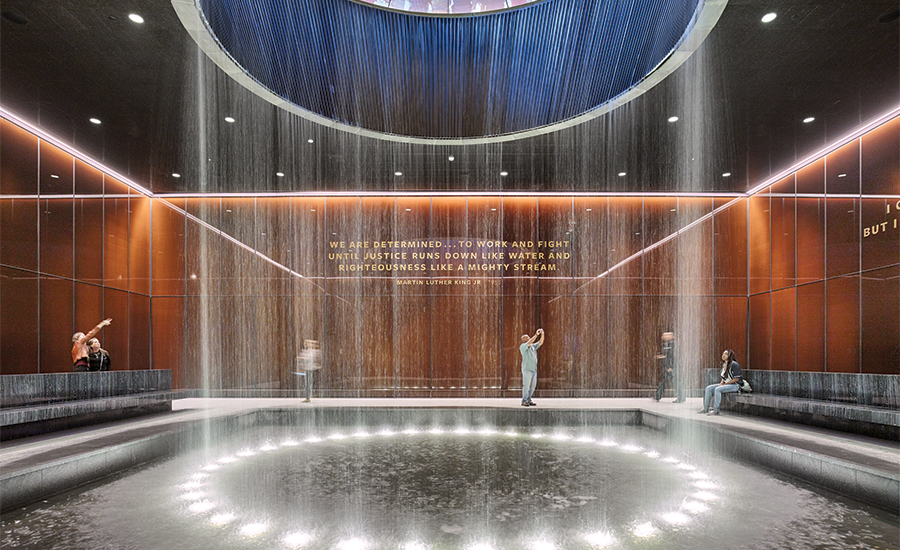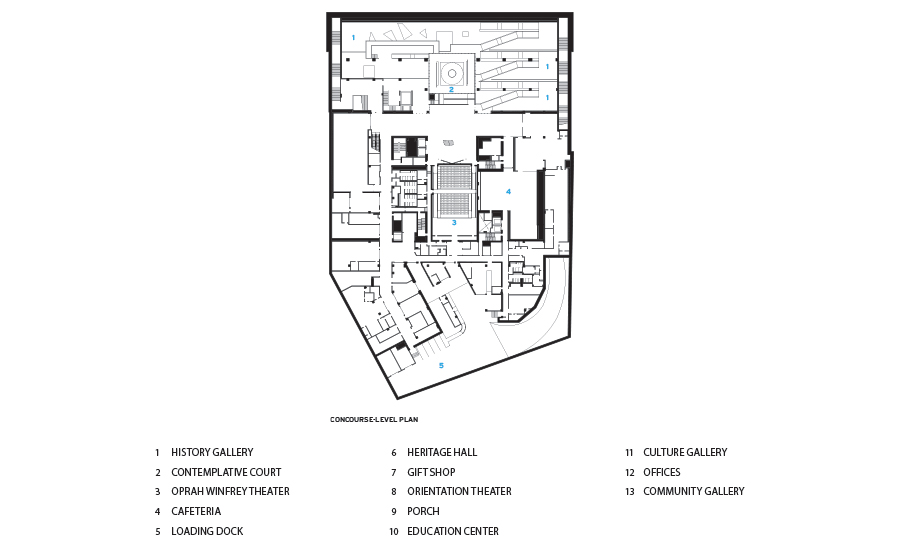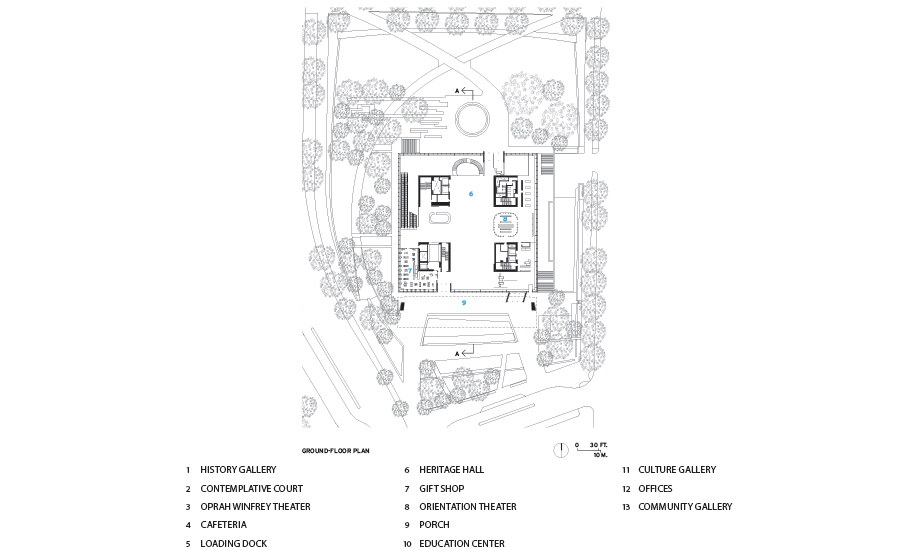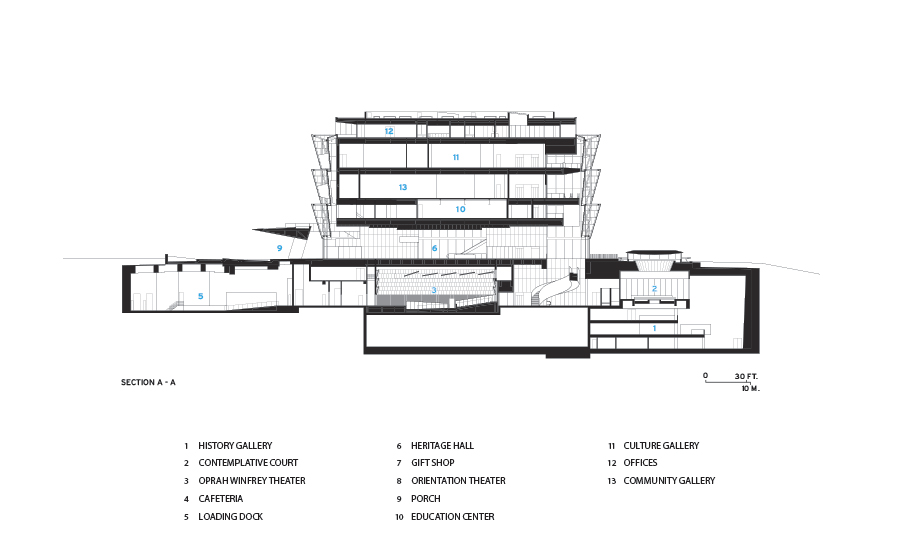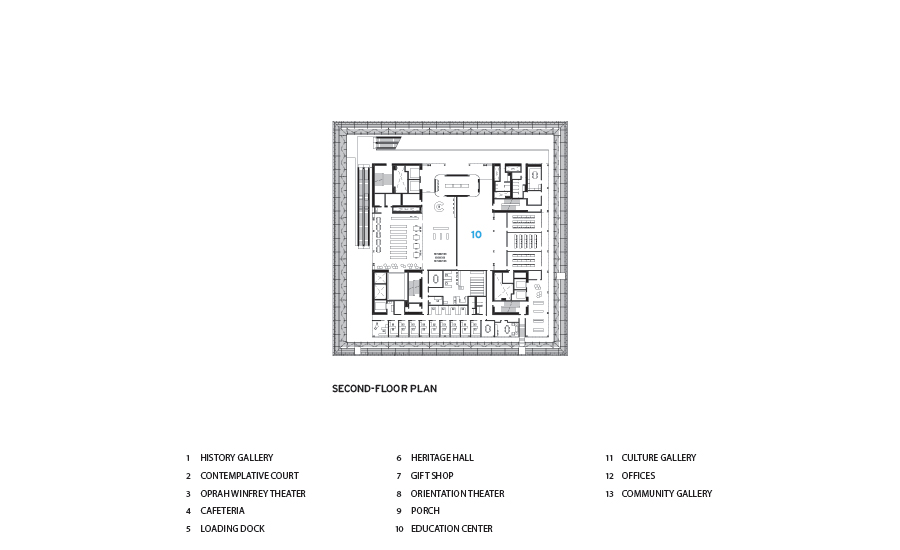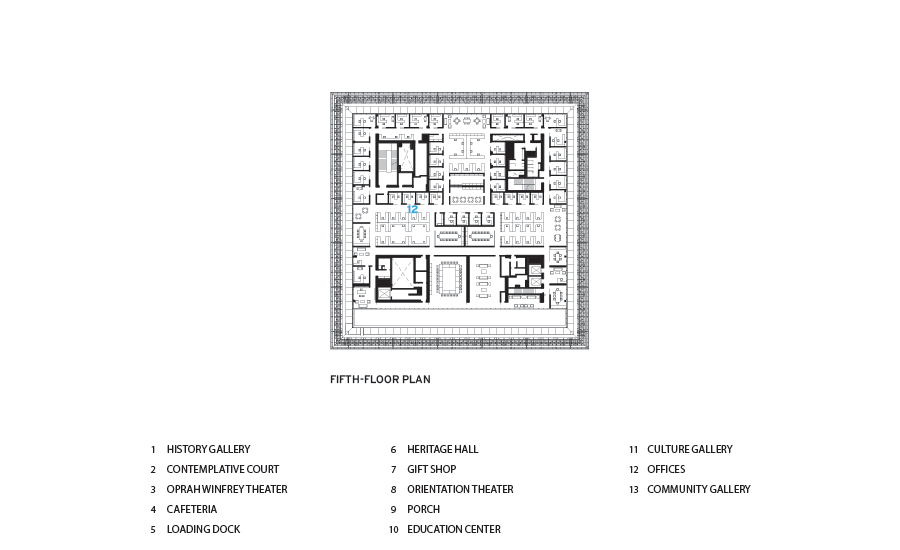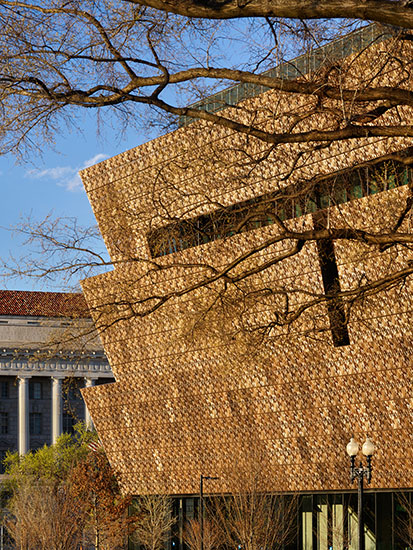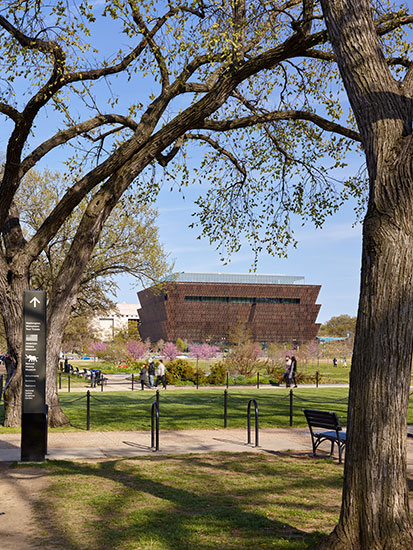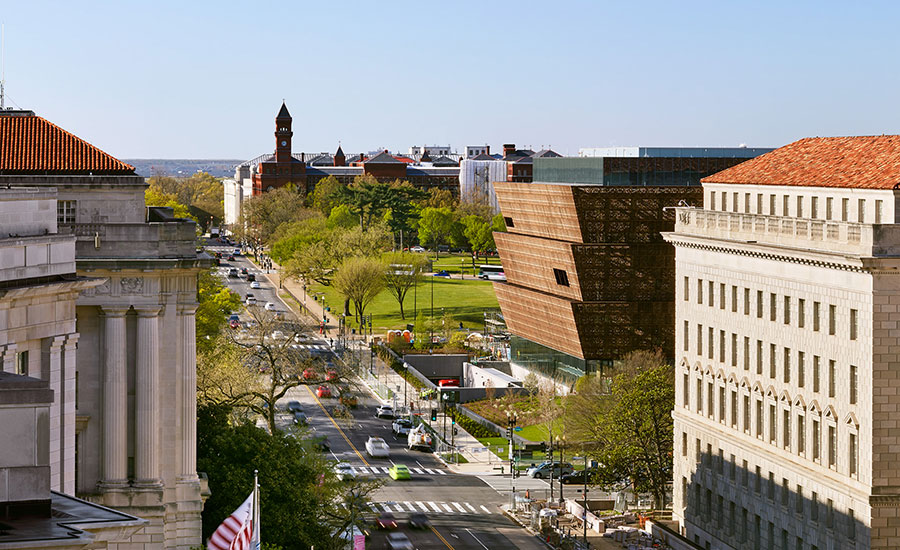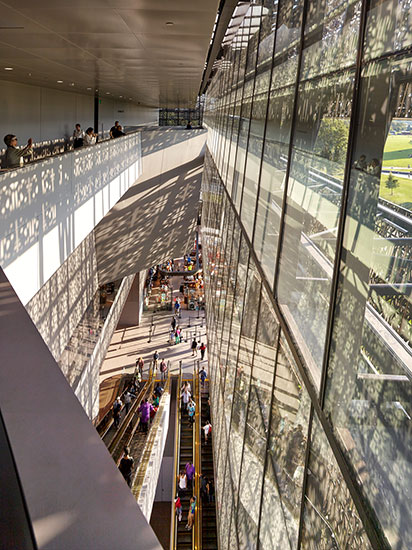National Museum of African American History and Culture by Freelon Adjaye Bond/Smith GroupJJR
Washington, D.C.
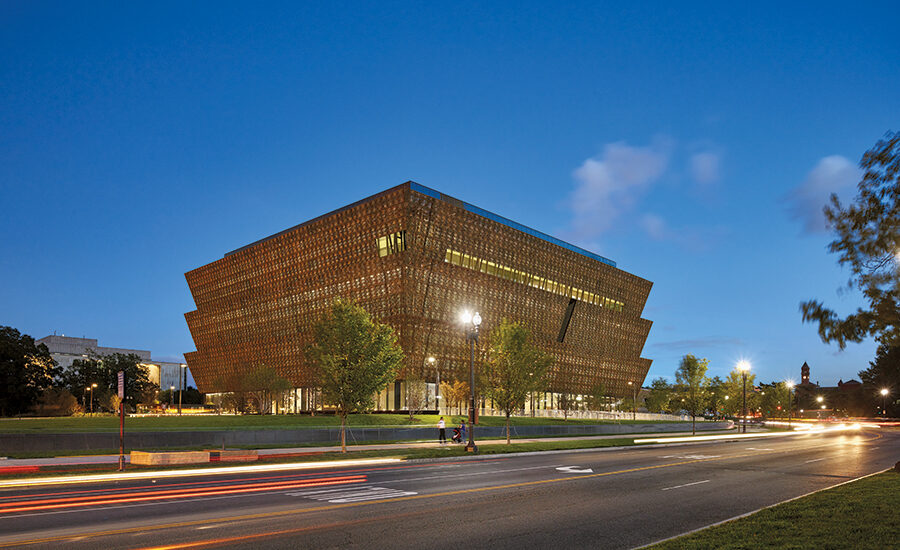
The National Museum of African American History and Culture by Freelon Adjaye Bond/Smith GroupJJR is one of six finalists for the Mies Crown Hall Americas Prize.
Photo © Alan Karchmer
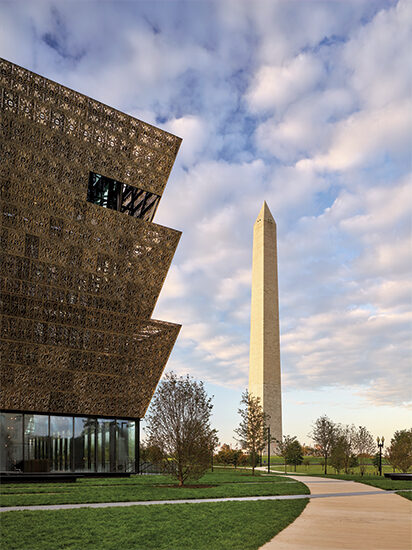
It occupies the last available spot on the National Mall, in the shadow of the Washington Monument.
Photo © Alan Karchmer
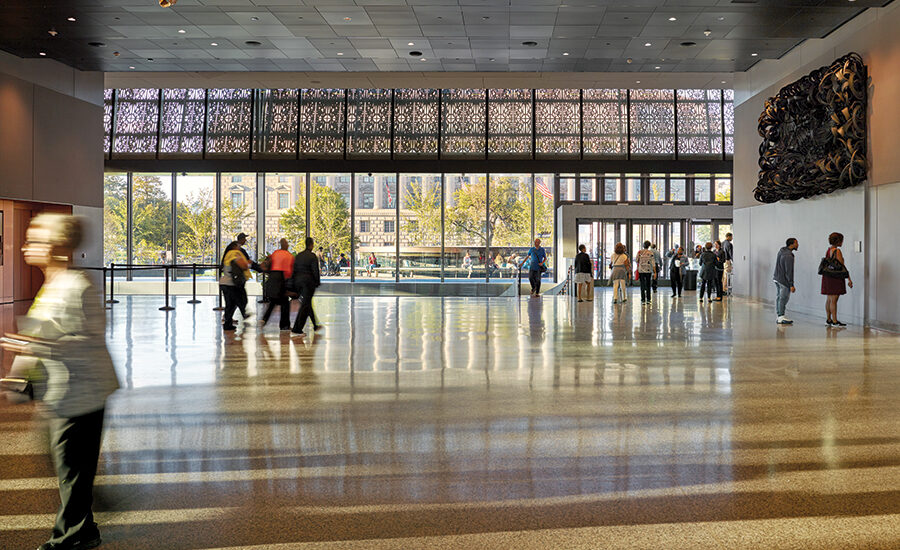
The heritage hall at the ground level is a vast lobby for welcoming visitors.
Photo © Alan Karchmer
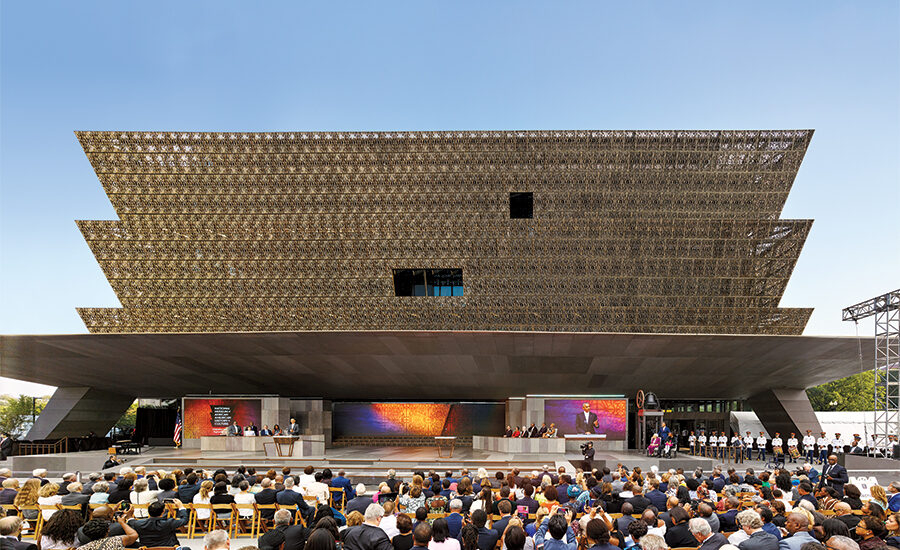
At the south entrance, a massive canopy referred to as the Porch spans 175 feet. President Obama presided over the museum’s opening here.
Photo © Alan Karchmer

In stark contrast to its Neoclassical neighbors, NMAAHC’s 250,000 square feet of facade are covered in a latticework of bronze-colored cast aluminum panels.
Photo © Alan Karchmer

Escalators move visitors through the upper-level galleries.
Photo © Alan Karchmer

A Jim Crow–era passenger car from the Southern Railway Company is exhibited within the below-grade history galleries. The 154,000-pound car was installed in the museum with two coordinated cranes before construction was complete. The slab supporting it is specifically designed for the load.
Photo © Alan Karchmer

A concrete guard tower from Louisiana State Penitentiary was cut from its original foundations and transported to the museum.
Photo © Alan Karchmer
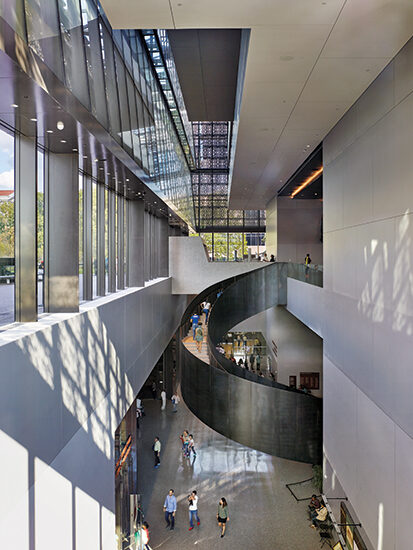
A self-supporting spiraling steel staircase links the lobby to the concourse level below.
Photo © Alan Karchmer

A Tuskegee aircraft hangs in the History galleries.
Photo © Alan Karchmer

Views through the facade’s latticework over the capital are possible from the upper-level galleries.
Photo © Alan Karchmer

The underground Contemplative Court, with cascading water and daylight streaming in from above, offers a moment of reflection.
Photo © Alan Karchmer, courtesy NMAAHC
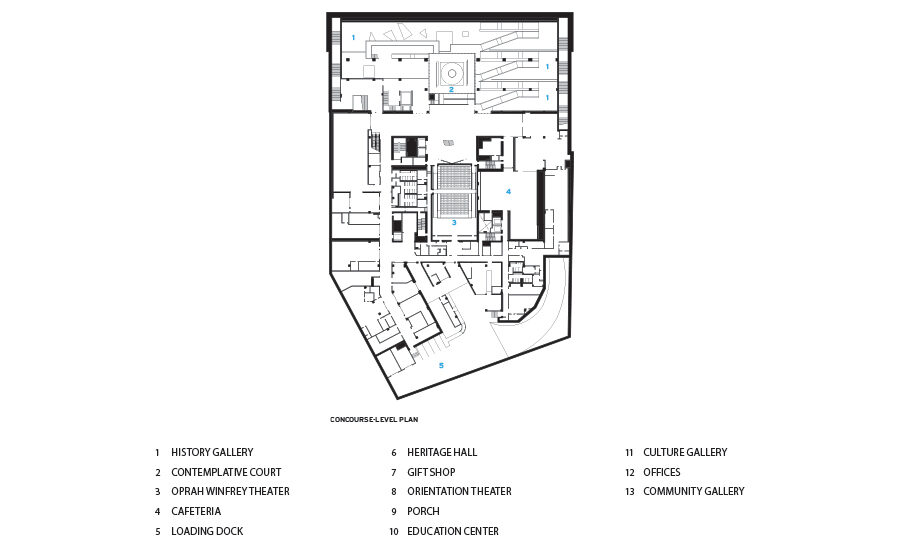
Concourse level plan
Image courtesy Freelon Adjaye Bond/Smith GroupJJR
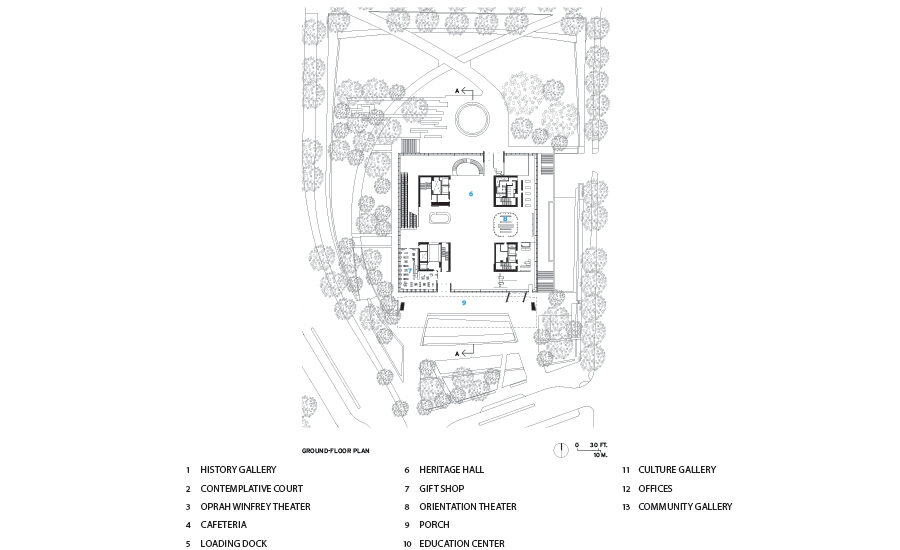
Ground floor plan
Image courtesy Freelon Adjaye Bond/Smith GroupJJR
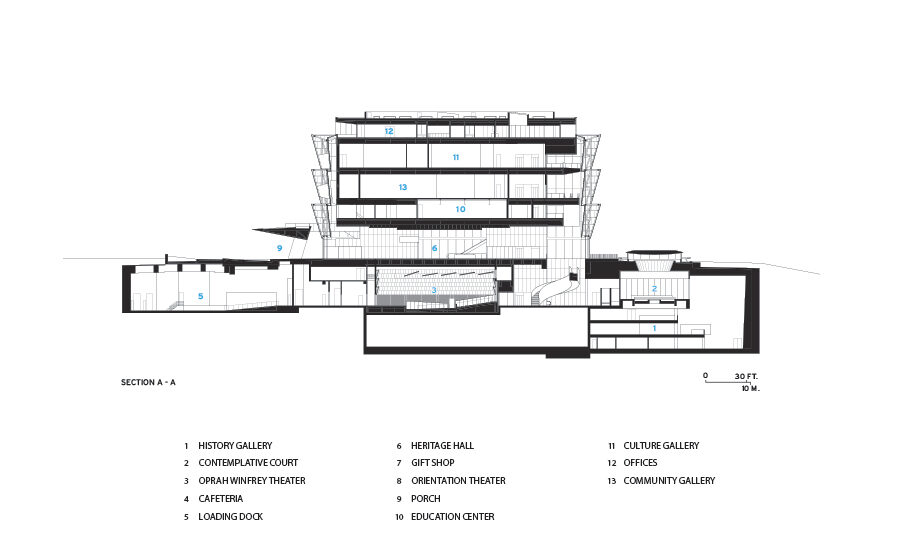
Image courtesy Freelon Adjaye Bond/Smith GroupJJR

Second floor plan
Image courtesy Freelon Adjaye Bond/Smith GroupJJR

Fourth floor plan
Image courtesy Freelon Adjaye Bond/Smith GroupJJR

Fifth floor plan
Image courtesy Freelon Adjaye Bond/Smith GroupJJR

Photo © Alan Karchmer

Photo © Alan Karchmer

Photo © Alan Karchmer

Photo © Alan Karchmer

Photo © Alan Karchmer

Photo © Alan Karchmer

Photo © Alan Karchmer

Photo © Alan Karchmer

Photo © Alan Karchmer

Photo © Alan Karchmer

Photo © Alan Karchmer

Photo © Alan Karchmer

Photo © Alan Karchmer

Photo © Alan Karchmer

Photo © Alan Karchmer

































The opening of the National Museum of African American History and Culture (NMAAHC) on September 24 was a long time coming. It has been over a hundred years since such a monument was first proposed by black Civil War veterans and 13 years since President George W. Bush signed legislation to build it, following decades of lobbying. The highly anticipated museum finally came to fruition just in time for President Barack Obama—who features prominently in one of its exhibits—to preside over the opening before leaving office.
The freestanding building, occupying five acres on the last available spot on the National Mall in Washington, D.C., is both monument and museum—and memorial, according to its designer, David Adjaye, who, with Phil Freelon, led the four-firm architectural team of Freelon Adjaye Bond/SmithGroupJJR. “This story has embedded in it so much complexity that it’s not just about telling that story,” says Adjaye. “This is more than a functional building to hold content but also a representative building—I felt compelled to find symbolism that would start to make a connection, but symbolism that wasn’t too dogmatic. One that was definitely not familiar immediately but would make you ask questions.”
The museum’s story starts in Africa, and Adjaye’s symbol is the corona, a three-tiered crown used in Yoruban art from West Africa. (The actual sculpture that served as inspiration for Adjaye is on five-year loan to NMAAHC from the Haus der Kunst in Munich and is displayed in the uppermost gallery.) The 250,000 square feet of facade that take on that shape are covered in a latticework of bronze-colored cast-aluminum panels that recall celebrated historical patterns by black ironworkers in the South.
The building’s compact exterior belies the sprawling galleries contained within. The structure extends as deep below grade as it rises above—just over 60 feet. In fact, visitors are encouraged to begin their tour at the very bottom. There, the history galleries begin in dark rooms with the story of slavery.
The building’s location is not far from the site where slaves arrived by boat in the nation’s capital, a center for the domestic slave trade. Built on swampy land where the Tiber Creek once flowed, the entire foundation had to be reengineered when the support for the excavation wall failed. “We encountered similar issues at the Museum of the American Indian on the opposite end of the Mall, but this area of the Washington Monument grounds was much more susceptible to the high water table,” says Hal Davis of Smith GroupJJR. “The excavated area contained too much degradable material and large boulders that interrupted the integrity of the wall, creating opportunities for water to get through.” The new foundation comprises a bathtub-like waterproofing system, with additional piles to tie down the slabs.
The exhibition opens up into a cavernous space as you ascend the ramping history galleries, passing large installations like a Jim Crow–era railroad passenger car and a plane, soaring overhead, used by the Tuskegee Airmen. NMAAHC is, in fact, a vertical museum, spanning multiple levels. As you approach grade, the contemplative court, with its circular cascade of water, offers a moment of reflection, and rest. The adjacent cafeteria offers up soul food.
Aboveground, the structure of the museum is more like that of a bridge than a building. The floors and facade—both the metal panels and the glass behind them—hang off four rectangular concrete-and-steel cores (which contain vertical transportation, restrooms, and mechanical space) toward the corners of the building, which have varying dimensions but are roughly 40 feet long. The entire building is supported by a steel superstructure that spans between those four cores —a convenient reference as well to the four “pillars” upon which NMAAHC metaphorically stands, which include the celebration and sharing of the museum’s content.
As a place, the museum is not to be missed. The notion that a place like this—a national commemoration of black history—did not exist before is astounding. As architecture, it is not beyond reproach. While on the outside it handsomely—and proudly—stands out against its white neoclassical neighbors, its interiors, with escalators and terrazzo flooring, leave you feeling as if you are at a mall, not on the Mall. Ralph Applebaum’s exhibition design, so moving inside the history galleries below grade, at times borders on kitsch within the busy installations of upper-level galleries that celebrate African-American achievements in music, sports, literature, and pop culture. The vast 22-foot-high heritage hall, which serves as the lobby on the ground floor, feels too empty, too corporate. One wonders if the idea for a forest of columns hanging from the ceiling—part of Adjaye’s original concept for that space but eliminated partly to save costs, and partly to display art instead—would have alleviated that sense.
Where the interiors excel are in the space between the facade and the enclosed galleries on the upper levels that allows dappled light to filter in from the metal screens. According to Adjaye, “Going out into that corridor, into that light-filled space, and then going back into this sort of dark box is an important part of keeping you engaged as you go up the building.” Indeed, as one completes the journey and reaches the lookout at the uppermost gallery, with its views over the capital city, there is a sense of triumph for this ongoing story and how it is told through the architecture of this building.
PeopleArchitect: Adjaye Associates
Architect of record: The Freelon Group
Associate architects: Davis Brody Bond, The Smith Group
Engineers: Structural - Guy Nordenson Associates/ Robert Silman Associates
Consultants: Landscape - GGN / Kathryn Gustafson
Exhibition Designer: Ralph Applebaum
General contractor: Clark Smoot Russell
|
ProductsStructural System Steel Frame Exterior Cladding Metal panels: Enclos Metal/glass curtain wall: Cast Corona Panels and carrier frames - Enclos Rainscreen: UHPC - Taktl Curtain wall: Enclos Green Roof: SemperGreen Glazing Glass: Interpane Skylights: Interpane Doors Entrances: Dawson Fire-control doors, security grilles: Total door Interior Finishes Acoustical ceilings: Pyroc Starsilent Suspension grid: Armstrong; USG; Ceilings Plus Cabinetwork and custom woodwork: Jefferson Millwork Paneling: Benjamin Moore / Sherwin Williams Plastic laminate: Abet Laminati / Nevamar Wood slat walls: Rulon Floor and wall tile: Terrazzo - Generally - Atlantic Refinishing and Restoration; Wall tile at cafeteria - Daltile Carpet: Shaw / Mannington Special interior finishes unique to this project: Theatre corona panels - GFRG – Plasterform; contemplative court glass — Bendheim; custom blackened copper ceiling — Pure + FreeForm Furnishings Chairs: Knoll Upholstery: Knoll Other furniture: Theatre Curtain - Secoa Conveyance Elevators/escalators: Escalators - Otis Plumbing Haws Corporation Energy Photovoltaic system: Sunpower |



